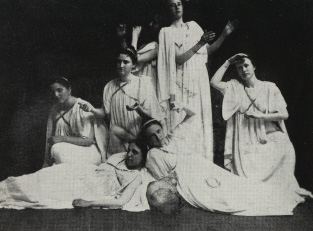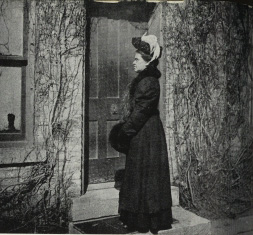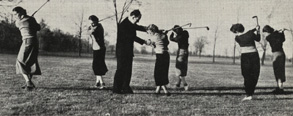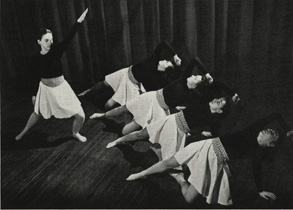






Prepared by the editor of Oberlin Alumni Magazine in 1941, Carroll K. Shaw, with the help of "Miss Mary Dick, '03, Miss Katherine von Wenck, and to the article by Miss Minnie Lynn, '28, in the April, 1935, issue of this magazine."
Oberlin Alumni Magazine , May 1941, pp 2-3+.
When Dr. Delphine Hanna died on April 16, another member of the pioneer group who brought fame to Oberlin by introducing radical ideas into the American educational system ended a long and fruitful career. Dr. Hanna was the first teacher of physical education at Oberlin, and she was one of the first persons in this country to see the need of scientific teaching of physical education. To her convictions, the Women's Department of Physical Education owes its very inception -- in 1885, such ideas were very progressive, and few were prepared to teach them.
Oberlin offered work of a sort in physical education in the [eighteen] seventies; from 1874 to 1880, the old Music Hall had served as the Ladies' Gymnasium, with student teachers in charge. President Fairchild voiced a self-evident truth in his report to the Board of Trustees in 1880, when he said, "A more thorough organization, under the charge of an officer of the College, would doubtless secure better results." When, in the following year, the old Music Hall was destroyed by fire, provision was made in the proposed annex to Ladies' Hall for a new gymnasium, and it was completed for the fall term in 1881.

When Miss Hanna began work as a school teacher in 1884, in Fairport, New York, she became convinced that both teachers and students needed physical education founded upon a scientific basis. A summer school term with Dio Lewis confirmed her in that view, and so she went to the private Normal School of Physical Training conducted by Dr. Dudley A. Sargeant of Harvard. It was in 1885, that Miss Hanna applied for a position at Oberlin.
Madame A. A. F. Johnston, Principal of the Women s Department at Oberlin, was interested in physical education for women, and became interested in Miss Hanna's views. She informed the would-be teacher that the remuneration for the first year was likely to be meagre, and asked Miss Hanna to submit a budget. The budget submitted called for the sum of $300-$400, and was accepted. The first years' salary of $350 was provided by Miss Julia Dickinson, life-long friend of Miss Hanna, who also gave a similar amount for the necessary initial equipment. The year 1885, then, marks the beginning of the department of physical education in Oberlin College.
 Right: Dr.
Delphine Hanna
Right: Dr.
Delphine HannaThe first year was a busy one for Miss Hanna. One hundred and twenty-five College women were examined and assigned to classes. In addition, there was a class for faculty women, one for public school children, and even one for College men! This last was made up of men in-terested in teachers' training who besought Miss Hanna to give them some of the systematic practice and theory she was giving the young women. Although college men of the [18]'80s played baseball and football under student leadership, there was no supervised instruction being offered them. Among the men in this first class were several who later became widely known in the field of physical education: Dr. Thomas Wood, for many years head of the physical education work at Teachers' College, Columbia; Dr. Halsey Luther Gulick, organizer of playgrounds and the Camp Fire Girls; and Dr. Fred Eugene Leonard, who later created and developed the Department of Physical Education for Men at Oberlin.
Teacher training was begun in Miss Hanna's second year with a one-year course; a second year was added in 1892. In 1901, the present four-year major in the Department of Physical Education for Women was given recognition, and in the following year the first woman in the United States to be graduated from a four-year course in physical educa-tion, leading to a Bachelor's degree, received her diploma. To further equip herself for teaching her subject scientifically, Miss Hanna went to the University of Michigan for advanced study, and in 1890, she received her medical degree. In 1903, she was made Director of the Women's Gymnasium, and Professor of Physical Education -- the first professorship in physical education in this country.
Sports were early introduced into the program by Miss Hanna to supplement the formal gymnastics. The first tennis courts were laid out in 1885-86 by Dr. Gulick and Dr. Wood. Basketball games were played with competing dormitory and class teams in 1894. In the spring of 1897, one out-of-door basketball court was enclosed for all-year use. After the erection of the Rockefeller Skating Rink in 1894, adjoining the gymnasium, it served in fall and spring for basketball and apparatus work. Bicycle lessons are mentioned, too, at this time!
Gradually the sports program of the physical education activities at Oberlin, as elsewhere, has become a predominant aspect of the picture. In the early days, physical exercise for women was prescribed for reasons of health. It is not reasonable to suppose that the young ladies in bloomers and skirts of those earlier days may have enjoyed their calisthenics, but enjoyment was not the primary purpose, at Oberlin or elsewhere.
Today, however, we find the good fun of the sports program at once the main attraction and the driving force of much of the physical education program. Instead of many college girls going to classes for calisthenics at stated intervals, one finds today an extensive program of sports enjoyed by literally hundreds of women in their free time, in addition to the regular class work which contin-ues as an important part of the work of the department.
The immediate aims of the present program have been stated to be "health, increasing appreciations and neuro-muscular powers as shown in definite skills, and increasing interests and social ability which can be developed in group and team work. The program is organized to give each girl an opportunity, first, to learn her physical limitations and status and how to develop better physical stamina; second, to develop sufficient skill in at least one individual sport to arouse a permanent interest in, and appreciation of it; and third, to provide for each girl an opportunity to participate in challenging group activities under conditions that are suited to her strength and capacity and interests."
Based upon the results of physical examinations given to each girl on entrance at Oberlin, Freshman girls take a six-week's course in "health fundamentals" at the start of the year. Each girl receives individual corrective work on such matters as posture, and the strengthening of weak arches. Much of this work is preventive as well as corrective.
 Much of the
regular class work which follows is very different from that offered
a few years ago. Less attention is paid to formal gymnastics,
apparatus work, and the like, and more stress is being laid on
training in the various sports. In the first year of the required
two-year course in physical education, the girls take in successive
six-week periods special training in each of the sports presented in
the program. In each period, the student may select one sport from
the several options offered, the particular sports offered depending
upon the season of the year. For example, the student may start the
semester with a six-week period in tennis, then elect another period
for swimming instruction, winding up the semester with instruction in
basketball or archery. Such training becomes immediately useful in
participation in the intramural sports program conducted by the
Women's Athletic Association.
Much of the
regular class work which follows is very different from that offered
a few years ago. Less attention is paid to formal gymnastics,
apparatus work, and the like, and more stress is being laid on
training in the various sports. In the first year of the required
two-year course in physical education, the girls take in successive
six-week periods special training in each of the sports presented in
the program. In each period, the student may select one sport from
the several options offered, the particular sports offered depending
upon the season of the year. For example, the student may start the
semester with a six-week period in tennis, then elect another period
for swimming instruction, winding up the semester with instruction in
basketball or archery. Such training becomes immediately useful in
participation in the intramural sports program conducted by the
Women's Athletic Association.
In the Sophomore year, the student may devote an entire semester to developing her skill in a single sport which, the year before, held special appeal for her. The more intensive work in a single sport will help her win a place on the teams competing in the intramural program.
During the past year, approximately 385 women have been enrolled in the required two-year courses in physical education for women. An even larger number of women participated in the intramural sports program organized by the Women's Athletic Association.
 Right and Above:
Today's program stresses activities which can be continued after
college.
Right and Above:
Today's program stresses activities which can be continued after
college.Some thirty-five girls participated in the Modern Dance Group, which during the year offers one or more public performances. A corresponding number of girls were enrolled in classwork in the field of the modern dance. To this should be added the considerable number of girls who elected tap dancing for one of their six-week periods.
Three hundred women have received instruction in swimming during the current year. Of this number, thirty-three women received instructor's certificates, and forty-three received senior life-saving certificates from the Red Cross after passing rigid tests.
The tennis tournament conducted last fall brought into competition 105 women, and twelve couples participated in the mixed doubles tournament. In addition there is constant demand upon all courts for unorganized tennis.
Eighty girls participated in class hockey competition, and 56 in class volleyball matches.
Sixty girls took instruction in golf during the spring and fall, and a corresponding number received instruction in archery. Each year, the girls participate in a telegraphic archery meet with several other colleges.
Class basketball competition enlisted the interest of eighty girls. Every Oberlin alumnus remembers the interest which surrounds the annual allstar Yale-Princeton basketball game.
Dormitory competition in volleyball brought out 175 women, and house basketball games brought into competition some 200 girls.
The little 29' x 44' room in which Dr. Hanna began her work at Oberlin in 1885, has now expanded to include the splendid new Hales Memorial Gymnasium and the Crane Swimming Pool. The playing fields available for women cover fourteen acres, and are beautifully landscaped throughout. They include eight tennis courts, two hockey fields, two indoor baseball diamonds, and one soccer field, plus a nine-hole practice golf course. And, thanks to Dr. Hanna's foresight, the department owns a cottage at the Lake, where the girls may go for out-door water sports.
On the sound foundations and prin-ciples established by Dr. Hanna has grown this program of organized physical education and sports training which forms such a significant part of the Oberlin of today. Truly a worthy monument of one of Oberlin's pioneer women, and a credit to those who have succeeded her."

![]() Click here to return to
"People of Oberlin: Images Over
Time".
Click here to return to
"People of Oberlin: Images Over
Time".
![]() Click here to return to the
"Lucy Stone walk-a-thon Tour" of
some herstoric sites in Oberlin.
Click here to return to the
"Lucy Stone walk-a-thon Tour" of
some herstoric sites in Oberlin.